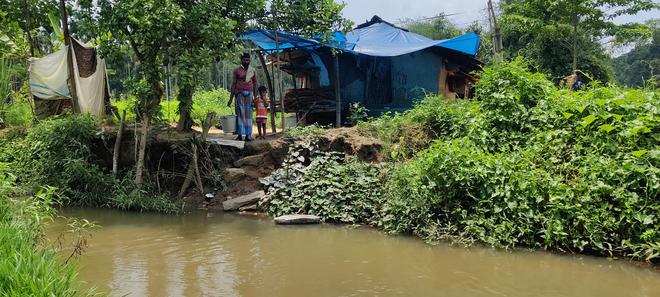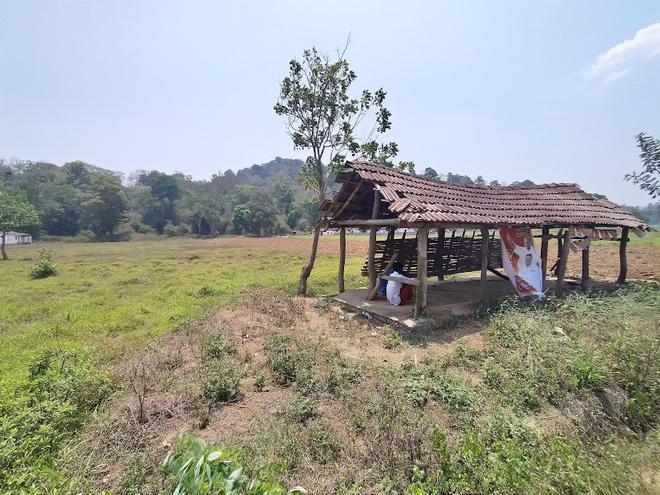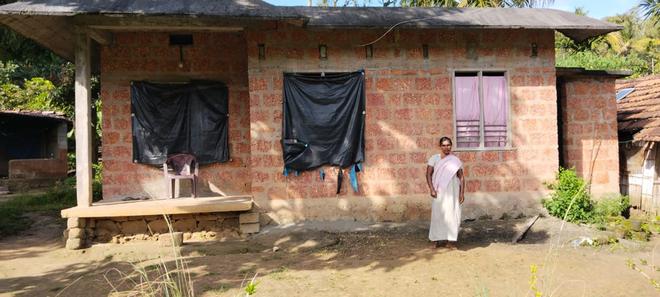A trip to the Chettyalathur tribal colony would mean leaving almost everything to chance. Even if you go during the day, when the weather is clear, in a four-wheel-drive cab from Cheeral, the last village with a taxi point, about 10 kilometres away, there could still be herds of wild elephants along the final stretch of the 3-km gravel road to the colony.
That’s how life has been for the settlers of Chettyalathur, a hamlet that straddles the trijunction of Kerala’s Wayanad Wildlife Sanctuary, Tamil Nadu’s Mudumalai Tiger Reserve, and Karnataka’s Bandipur Tiger Reserve.
“We have been living in the settlement for many generations, but frequent attacks by wild animals are forcing us to leave,” bemoans Ramesh, 44, a farmer at Chettyalathur, the largest of the 110 forest settlements in the wildlife sanctuary.
Crop raids by wild animals have become so common that the residents of Chettyalathur were forced to restrict cultivation of rice to just about 10 acres from nearly 45 acres two years ago. But that’s just one aspect of their misery. The only primary school in the settlement, thatched with asbestos sheets, failed to receive a fitness certificate from the Noolpuzha grama panchayat and is heading for closure, rues Venugopal Chettiyar, another resident of the colony. The settlers say that the school was set up in 1975 after two children were trampled upon by wild elephants while they were returning from their school at Pattavayal located 10 km away in Tamil Nadu.
In 2011, the Union Ministry of Forest Environment and Climate Change (MoEFCC) launched a project that would allow forest settlers to relocate to areas of their choice outside. With 101 of the 186 families of Chettyalathur choosing to move out, the student strength of the government primary school fell from 70 to just about 11. Ramesh says he has enrolled his children at a school in Cheeral, and their daily commute is a private vehicle hired for the purpose.
While the voluntary relocation project was directly under MoEFCC’s Integrated Development of Wildlife Habitat Scheme, in 2020, a new scheme was worked out based on which the Centre and the State would share the cost of relocation on a 60:40 basis.
Hassled by frequent encounters with the wild, settlers welcomed the scheme with enthusiasm, but official apathy and lack of funds stopped the project in its tracks and the first phase of relocation is dragging on. A study conducted in 2010 under the supervision of S. Sankar, scientist at the Kerala Forest Research Institute, Peechi, had identified 1,388 people belonging to 880 families across 14 settlements inside the sanctuary for relocation in the first phase. It was to be done at an estimated cost of ₹80 crore. The study had identified 2,613 families from the 110 settlements inside the sanctuary for shifting out.

A male above 18, irrespective of his marital status, an unmarried female over 18 years, a physically and mentally challenged person regardless of age or gender, a minor orphan, a widow or a woman divorcee is an individual beneficiary unit or a family according to the guidelines of the relocation project. Each eligible family is paid a compensation of ₹15 lakh irrespective of the nature or extent of the land it possesses. The government will identify land for relocation only for the tribal Paniyars and Kattunayakars so that they don’t get defrauded.
“While the government allotted ₹22 crore for the project in Chettyalathur hamlet in 2018, the fund was unutilised,” says N. Badusha, president of Wayanad Prakruthi Samrakshana Samithy, a forum of environmentalists. He blames it on laxity on the part of revenue officials.
If the project moved at a snail’s pace until 2017, it has come to a grinding halt now, say the settlers of Chettyalathur, who have found themselves in a catch-22 situation. They can neither move out, nor can they fortify their dwellings in the colony as all development work inside forest region is barred, says Badusha, shrugging his shoulders.
Three types of settlers
Settlers in the sanctuary arrived in their colonies in three different ways – traditional forest dwellers were allowed to stay on and issued title deeds in the Raj era; forest land was leased out to people in the 1940s and 50s in the wake of the Bengal famine to grow more food; the third category of people were those who purchased parcels of land from these occupants. Rice cultivation, collecting minor forest produce and cattle rearing remain the main livelihoods of the people of these settlements.
“We are stuck in a time warp while the world has moved on,” says Bijo Thomas of Manimunda settlement. “Basic amenities such as electricity, roads, education, and health care are still a far cry and, in many settlements, children are forced to travel kilometres on foot through dense forests to study,” he says. Bijo’s grandfather, Jacob, arrived at the settlement some 60 years ago and the family came to possess eight acres of leased land including seven acres of paddy field.
“But nobody can call it a paddy field now as we have kept it fallow for several years in the wake of frequent crop raids by wild animals,” he says.
Bachelors abound
At 36, Bijo is unsure if he will ever be able to find a bride as no parent is willing to send his/her daughter to the forest hamlet. This isn’t the case of Bijo alone, but many young men in these settlements face forced bachelorhood.
Livestock in these settlements is as vulnerable as agricultural crops. One of Bijo’s cows was killed by a tiger some six months ago and he is still waiting for compensation from the government. “We are denied compensation for crop loss or loss of cattle and banks deny us loans citing lack of property ownership documents,” says Bijo.
Most settlers want to leave the forests taking up the voluntary relocation scheme, but they are trapped, says Badusha citing the inordinate delay in the implementation of the scheme.
₹2.8 crore credited
Reports say that the MoEFCC credited ₹2.8 crore in the joint account of the beneficiaries, the Tribal Development Officer of Sulthan Bathery, and the Assistant Wildlife Warden of the sanctuary in January 2019 for rehabilitating 28 families of Chettyalathur belonging to the Kattunayakar and Paniya tribal groups. But that has not happened yet.
Velukkan, alias Nambi, a Paniya tribal leader of the Chettyalathur, says his family has been staying in a makeshift hut on the banks of a nearby rivulet after a troop of monkeys made the tiled roof of his house their playground, causing it to cave in. “We were denied permission to rebuild or build houses after the commencement of the relocation project,” he says. When it pours, his family takes shelter inside the dilapidated primary school.

Velukkan was among the first lot of beneficiaries of the scheme, but he’s waiting for his turn to come. “No one knows when it is going to be completed,” he says, smiling wryly. While Kerala announced 100% electrification of villages, students in most of these settlements study in the glow of flickering kerosene lamps.
Land purchasing committee
Since it’s incumbent on the government to find suitable land for the tribal Paniya and Kattunayakar groups, the Department of Tribal Welfare constituted a purchasing committee to identify and acquire land for them. A district-level monitoring committee has also been set up for the purpose with the district collector as its chairperson and the warden of the wildlife sanctuary as secretary. “But the committee has not convened any meeting in the last three years,” says Badusha, a member of the committee.
A few weeks ago, the residents of the Pangalam hamlet took out a march to the office of the wildlife warden demanding speedy completion of the relocation project. While senior officials reached the colony to calm frayed nerves, assurances have remained only on paper, says Govindan, a tribal leader of Pangalam hamlet.
There are concerns regarding compensation too. While a majority of the families of Chettyalathur have agreed to move out, those in possession of patta land (land with title deeds) think it is unfair on the part of the government to not compensate them adequately. Some seven families that together own around 40 acres of patta land do not want to move out unless they are paid the market price as decided by the government. “I get a return of about ₹5 lakh from the three acres of land I own as I have cultivated coffee, pepper and arecanut there. How do I purchase even half an acre of land outside the hamlet with the ₹15 lakh given by the government?” asks a land-owning farmer.
Badusha says when the issue was brought up before the monitoring committee, it was agreed that a special package would be worked out for land-owning farmers. “The chief secretary directed the wildlife warden to draft a proposal and a project for the purpose. Hopefully it will come through,” he adds.

Meanwhile, the fate of the 44 Kattunayakar families that were relocated from the Kurichiyad hamlet remains uncertain. Although land was identified and allocated for them, the registration process has been dragging on for several years now, which has forced the families to continue to stay in the settlement, which is about 10 kms away from Chettyalathur.
Dinesh Kumar, Wildlife Warden of the Wayanad sanctuary, says the funds released for the relocation of the settlers in 2018 were used for the purpose until January this year. The outbreak of COVID-19 threw a spanner in the works, but identification of land for the 30 tribal families of Chettyalathur is under way, he says.
“We have submitted a revised proposal of ₹36 crore as per the project’s revised norms for the rest of the people in the 14 settlements incorporated under the project and we have it approved,” he says. A sum of ₹5 crore was released by the Union government recently to relocate the beneficiaries of Chettyalathur and Pangalam settlements. The remaining amount will be sanctioned once this is used up, he explains.

Shortage of funds was the reason for the delay in rehabilitating the remaining 23 of the 75 tribal families from the Kurichiyad settlement. “But we are trying to raise funds for this with the support of the Tribal Development department,” he says, adding it will be resolved in two months.
There’s no dearth of promises and revised timelines. “The sanctuary has of late become a hotspot of human-animal conflict and a tragedy can be averted if the project implementation happens on a warfooting,” warns Badusha.







